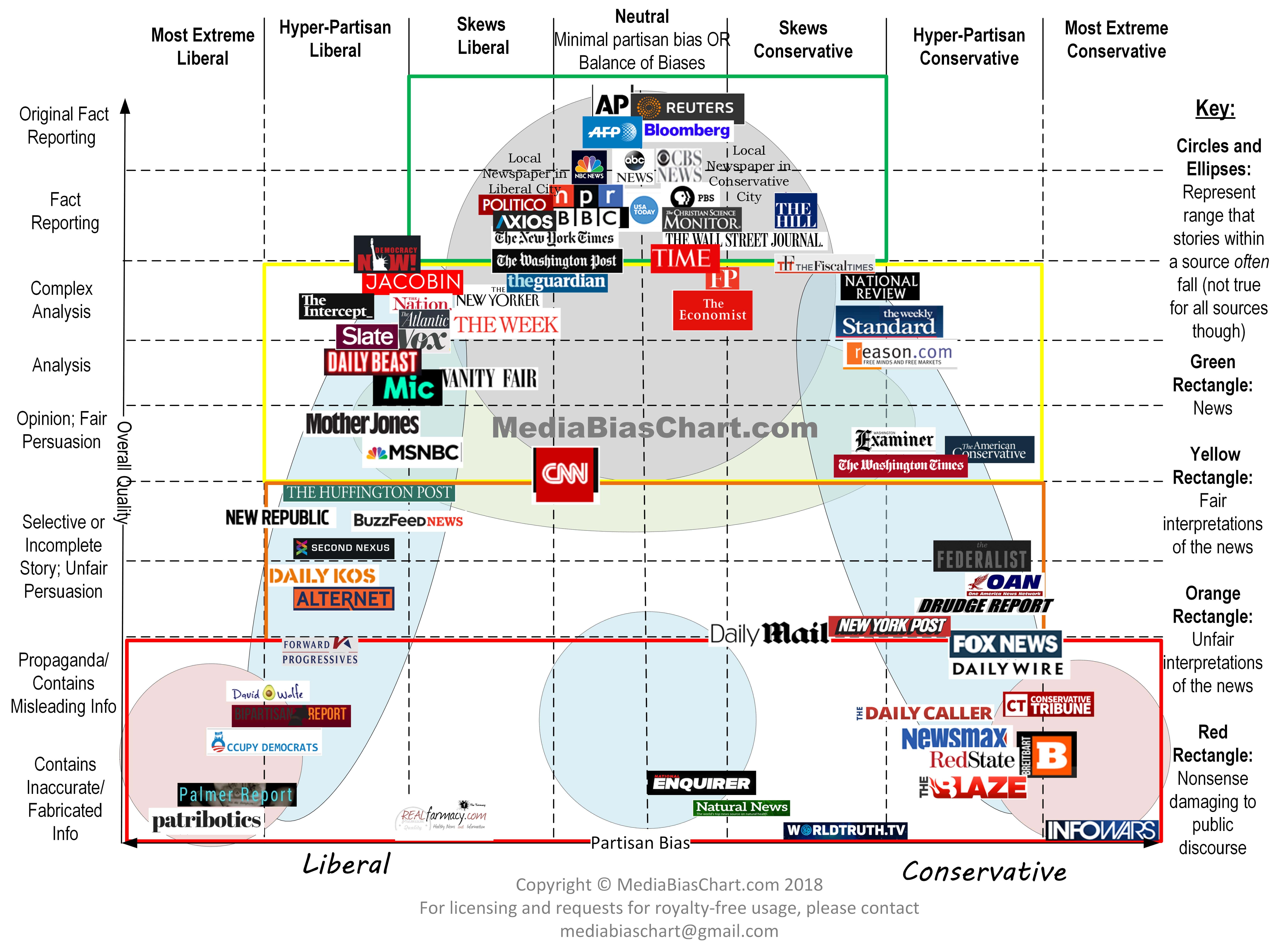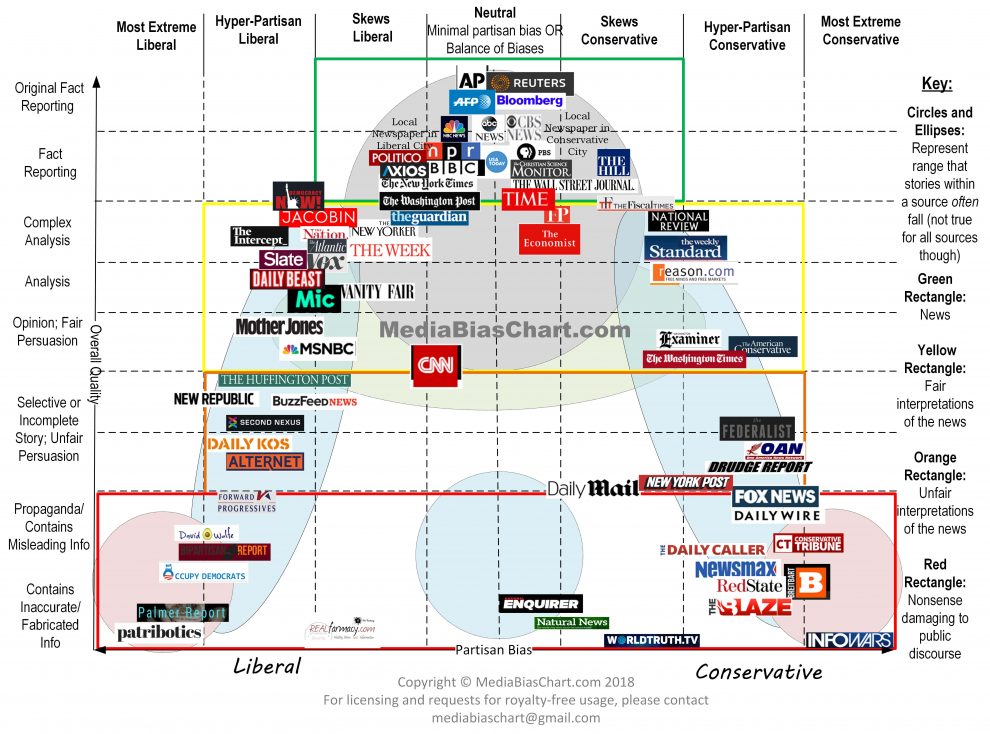American journalism is losing its objectivity.
That’s according to a new analysis on news discourse by the RAND Corporation RAND, +0.51% In the study, released Wednesday, researchers found a major shift occurred between 1989 and 2017 as journalism expanded beyond traditional media, such as newspapers and broadcast networks, to newer media, including 24-hour cable news channels and digital outlets. “Notably, these measurable changes vary in extent and nature for different news platforms,” it found. RAND is a nonprofit nonpartisan think tank based in Santa Monica, Calif.
“Our research provides quantitative evidence for what we all can see in the media landscape,” said Jennifer Kavanagh, a RAND senior political scientist and lead author of the report, the second in a series on the phenomenon of “Truth Decay,” the declining role of facts and analysis in civil discourse and its effect on American life. “Journalism in the U.S. has become more subjective and consists less of the detailed event- or context-based reporting that used to characterize news coverage.”
‘Journalism in the U.S. has become more subjective and consists less of the detailed event- or context-based reporting that used to characterize news coverage.’
The analysis — carried out by a RAND text-analytics tool previously used to scan for support for and opposition to Islamic terrorists on social media — scanned millions of lines of text in print, broadcast and online journalism from 1989 (the first year such data were available via Lexis Nexis) to 2017 to identify usage patterns in words and phrases. Researchers were then able to measure these changes and compare them across all digital, media and print platforms.
Researchers analyzed content from 15 outlets representing print, television and digital journalism. The sample included the New York Times, Washington Post and St. Louis Post-Dispatch, CBS CBS, +0.04% , ABC DIS, -0.34% , CNN T, +0.57% , Fox News FOX, +2.05% FOXA, +2.22% , MSNBC CMCSA, +0.81% , Politico, the Blaze, Breitbart, Buzzfeed Politics, the Daily Caller and the Huffington Post. They found a “gradual and subtle shift” between old and new media toward a more subjective form of journalism.
Don’t miss: How biased is your favorite news source? You probably won’t believe this chart
Before 2000, broadcast news segments were more likely to include relatively complex academic and precise language, as well as complex reasoning, the researchers said. After 2000, however, broadcast news became more focused on-air personalities and talking heads debating the news. (The year 2000 is significant as ratings of all three major cable networks in the U.S. began to increase dramatically.)
After 2000, broadcast news became more focused on-air personalities and talking heads debating the news. Traditional newspaper made the least dramatic shift over time.
Traditional newspapers made the least dramatic shift over time, the study observed. “Our analysis illustrates that news sources are not interchangeable, but each provides mostly unique content, even when reporting on related issues,’’ said Bill Marcellino, a behaviorial and social scientist with RAND and co-author of the report. “Given our findings that different types of media present news in different ways, it makes sense that people turn to multiple platforms.”
It’s not the only report to find a shift toward opinion and subjectivity in news. “Tumultuous news cycles have made an impact on global opinions regarding media,” according to U.S. News & World Report’s 2019 countries ranking released earlier this year. Some 63% of people say that there are no longer any objective news sources they can trust, and 66% say internet news and content is dividing people rather than uniting them. What’s more, more than 50% agree that political and social issues around the world have gotten worse over the past year.
Some 63% of people agree that there are no more objective news sources, and 66% say internet news and content is dividing people rather than uniting them.
That survey drew on answers from 20,301 people around the world. Individuals from 36 countries in four regions — the Americas, Asia, Europe, and the Middle East and Africa — were surveyed: 11,238 were “informed elites” (college-educated people who consider themselves middle class) and 5,963 were “business decision makers” (senior leaders in an organization or small-business owners). The rest were defined as adults over 18 years of age.
Don’t miss: Political-communication scholar has a catchy new name for fake news: V.D.
In the U.S., President Trump has labeled media outlets that have reported critically on his administration as “fake news,” and has described CNN, NBC, ABC, CBS and the New York Times NYT, +0.79% as “the enemy of the American people.” In one tweet TWTR, -2.09% meant to defend Sarah Sanders, the embattled White House press secretary, the president wrote: “Most will never cover us fairly & hence, the term, Fake News!”
Most Facebook users did not share fake news during the presidential campaign, but those who did were mostly Republicans over the age of 65.
The good news: Most Facebook FB, -0.90% users did not share any fake news articles during the 2016 U.S. presidential campaign, according to a study released earlier this year. The small number who did were mostly Republican-identifying Americans over the age of 65. The findings suggest the need for “renewed attention” to educate “particular vulnerable individuals” about misleading information, the authors said.
So why are Republican baby boomers more likely to share fake news on Facebook? One theory: As they didn’t grow up with technology, they may be more susceptible to being fooled in an online environment. (Case in point: the variety of scams that have had success with older Americans by preying on their lack of familiarity with how computers and technology work.)
In 2018, patent attorney Vanessa Otero released a chart on the most trusted news sources and how biased they were. AP and Reuters TRI, -0.35% ranked as the least biased. “I think the extremes are very toxic and damaging to the country,” she told MarketWatch. “These extreme sources play on people’s worst instincts, like fear and tribalism, and take advantage of people’s confirmation biases.”
Here’s that chart:

Get a daily roundup of the top reads in personal finance delivered to your inbox. Subscribe to MarketWatch’s free Personal Finance Daily newsletter. Sign up here.








